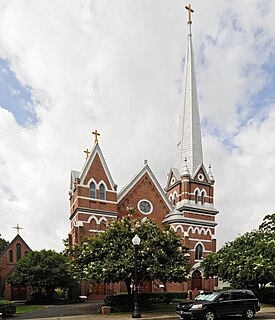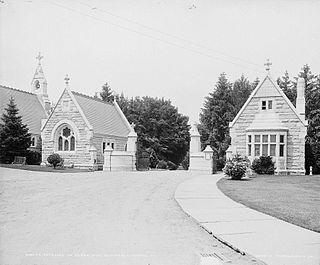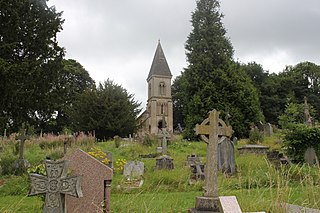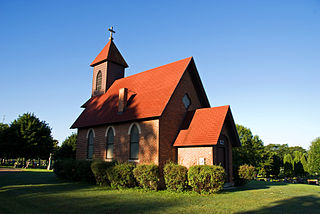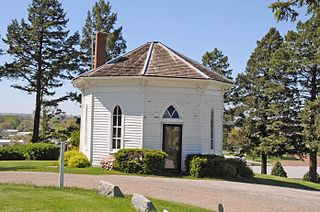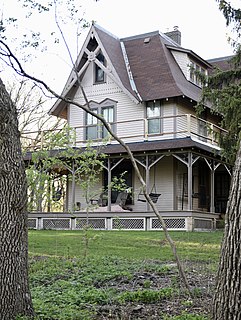James Stephen Hoover and Elizabeth Borland Memorial Chapel | |
 | |
| Location | Buffington Dr. Eau Claire, Wisconsin |
|---|---|
| Coordinates | 44°48′44″N91°31′29″W / 44.81214°N 91.52466°W Coordinates: 44°48′44″N91°31′29″W / 44.81214°N 91.52466°W |
| Built | 1936 |
| Architectural style | Gothic Revival |
| NRHP reference # | 99001662 |
| Added to NRHP | January 7, 2000 |
The James Stephen Hoover and Elizabeth Borland Memorial Chapel is located in Eau Claire, Wisconsin. It was added to the National Register of Historic Places in 2000 for its architectural significance. [1] [2]

Eau Claire is a city in Chippewa and Eau Claire counties in the west-central part of the U.S. state of Wisconsin. Located almost entirely in Eau Claire County, for which it is the county seat, the city had a population of 65,883 at the 2010 census, making it the state's ninth-largest city. Eau Claire is the principal city of the Eau Claire, Wisconsin Metropolitan Statistical Area, which is a part of the Eau Claire-Menomonie Combined Statistical Area.

The National Register of Historic Places (NRHP) is the United States federal government's official list of districts, sites, buildings, structures, and objects deemed worthy of preservation for their historical significance. A property listed in the National Register, or located within a National Register Historic District, may qualify for tax incentives derived from the total value of expenses incurred preserving the property.
The Hoover-Borland Chapel is a funeral chapel in Lakeview Cemetery, on the bluff above Half Moon Lake. It is in Neo-Gothic Revival style, clad in random ashlar stone, and trimmed in Bedford limestone. The front entrance is a pointed arch door, with a rose window above. Each side has four stone buttresses and pointed-arch windows. The roof is covered in ceramic tiles, and a small metal spirelet topped with a Latin cross rises from the ridge. [3]

Gothic Revival is an architectural movement popular in the Western world that began in the late 1740s in England. Its popularity grew rapidly in the early 19th century, when increasingly serious and learned admirers of neo-Gothic styles sought to revive medieval Gothic architecture, in contrast to the neoclassical styles prevalent at the time. Gothic Revival draws features from the original Gothic style, including decorative patterns, finials, lancet windows, hood moulds and label stops.

Indiana limestone — also known as Bedford limestone — is a common regional term for Salem limestone, a geological formation primarily quarried in south central Indiana, USA, between the cities of Bloomington and Bedford.

A rose window or Catherine window is often used as a generic term applied to a circular window, but is especially used for those found in churches of the Gothic architectural style that are divided into segments by stone mullions and tracery. The name "rose window" was not used before the 17th century and according to the Oxford English Dictionary, among other authorities, comes from the English flower name rose.
Inside are simple wooden pews, and a poured concrete altar with a silver cross. The walls are plastered. The roof is supported by King-post wood trusses, exposed rafters and purlins. Christian symbols are painted on the trusses. [3]
Lakeview Cemetery was established in 1867 by West Eau Claire. It was Eau Claire's second official cemetery, after Forest Hill, which was established in 1862, though people had been buried on the bluff that would become Lakeview as early as 1858. After Lakeview was established, Byron Buffington a local businessman and civic leader, donated 15 acres to the cemetery in honor of his parents George and Pluma Buffington. George had also been a businessman, running the Niagara House hotel, co-owning the Valley Lumber Company, serving as mayor of Eau Claire, and founding the Eau Claire Street Railroad Company. [3]
Byron A. Buffington was an American businessman and politician.
Frances "Fannie" Hoover married Byron Buffington in 1874. Her father James was a butcher in Eau Claire from 1866 to 1898. Elizabeth Borland was her mother. Around 1936 Fannie donated the Hoover-Borland chapel to the cemetery in honor of her parents. [3]
The chapel was designed by John Tilton of Chicago in a rather simplified Gothic Revival style and built in 1936. [4] The chapel was built by local contractors Hoeppner and Bartlett for $25,000. The chapel served two initial aims: the basement contains 42 receiving vaults where bodies can be stored during the winter, until the ground thaws for digging. The upper part of the chapel is used for burial services. [3]
